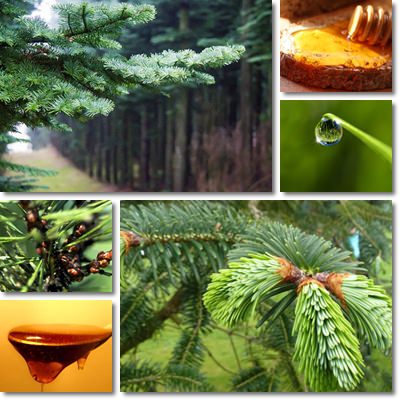Also known as fir tree honey or fir tree honeydew honey, pine honey is a variety made from the honeydew collected from certain insect species that feed off fir tree sap. The insects eat the sap and excrete a sticky, sugary liquid called honeydew. Honey bees collect the honeydew produced by these insects and use it to make a flavorful, dark honey known as fir tree or pine honey. This particular variety is appreciated for its flavorful, resinous, mildly sweet taste, rich color and impressive antiseptic, expectorant, antioxidant and energizing properties.
What is honeydew honey? Pine honey is a variety of honeydew honey. What makes it different from other varieties such as acacia honey is that it’s not made from flower nectar, but from honeydew, hence its name. Honeydew is what insects feeding on tree sap, in this case fir tree sap, excrete. Bees collect this sugary, gluey waste product and make honey from it. Examples of tree species that are sources of honeydew include: the European silver fir (Abies alba), the Greek fir (Abies cephalonica), the Turkish pine (Pinus brutia), the red and black beech from New Zealand (Nothofagus fusca and Nothofagus solandri) etc.

So pine honey is made of honeydew bees collect from insects that feed on fir tree sap. What is interesting is that this particular type of honey is not always called honey simply because it is not made from flower nectar as most varieties are, but from honeydew. The choice of name depends on individual state regulations. However, despite being made from something different than flower nectar, pine honey and other honeydew honey varieties are still produced from raw materials with a similar composition as the nectar (for example, both honeydew and flower nectar contain carbohydrates, particularly glucose and fructose, as well as amino acids and antioxidants) and special honey bee enzymes. This is why honeydew products are labelled as honey in most parts of the world.
What color is pine honey? Pine honey has a distinct appearance and is generally medium to dark amber, with greenish and brownish highlights. The variety has a thick consistency, being particularly dense, a trait which contributes to its popularity and distinctive look. See more honey varieties on our honey page.
What does pine honey smell and taste like? The honey has very little odor, except for a faded resinous smell. It has a mild taste with moderate sweetness and a mildly resinous, woody, warm flavor. However, there is a variety made from the sap of a fir tree species from the Mainalo mountains in Greece which is uncharacteristically sweet, with a strong vanilla flavor.

What about the benefits?
How is pine honey good for you? Pine honey shares similar benefits with other honey varieties. These are the most noteworthy 9 properties and health benefits of pine honey:
1) Rich in oligosaccharides. Pine tree honey is a rich source of oligosaccharides, natural sugar-based compounds with digestive benefits. More exactly, oligosaccharides have a probiotic action, supporting healthy gut flora. Actually, oligosaccharides are actually a component of dietary fiber, hence their beneficial action on digestive health.
2) Has energizing and anti-hypoglycemic properties. Pine honey is basically sugar. It contains natural, non-refined sugars, primarily fructose and glucose. The sugars are taken in quickly by the body and give instant energy, making the honey ideal for when you become hypoglycemic and experience dizziness or fainting sensations. The honey helps manage hypoglycemia symptoms, giving one sufficient energy to have a chance to enjoy a more substantial and nutritious meal.
3) Crystallizes very slowly. What makes pine honey crystallize slower than other varieties? When the fructose content in honey is higher than the glucose content, the resulting honey variety crystallizes slowly. This is also the case for pine honey and honeydew honey in general. It has been shown that it takes up to 18 months for certain pine honey varieties to crystallize. This is good because it gives us enough time to enjoy our jar of delicious honey before it begins forming crystals.
4) Boasts antiseptic properties. The antiseptic properties of pine and other honey varieties are a result of the presence of several different components with antimicrobial effects, namely an enzyme from bees called glucose oxidase, the acidic pH and the low moisture content of the honey. Bees secrete glucose oxidase, which is an enzyme that helps synthesize hydrogen peroxide from glucose. Hydrogen peroxide is a natural disinfectant and immune modulating molecule. Our own body produces hydrogen peroxide, which is used to call on white blood cells to repair cell damage and fight bacteria, viruses and other harmful agents. The presence of this particular compound in honey accounts for its antiseptic action.
Moreover, the acidic pH of pine honey (4.6 to 4.8) further contributes to its antimicrobial effects. Lastly, the low moisture content inhibits bacteria growth, adding to the antibacterial action of the variety. Studies indicate the honey is effective even against pathogenic strains of E. coli and other bacteria that could infect the respiratory and digestive systems and skin. However, it is important to make sure you purchase real pine honey if you want to enjoy such health benefits.
5) Great for sore throat and respiratory infections. Pine honey is helpful for respiratory tract infections because of its antimicrobial action. Moreover, its density and dry stickiness help it stick to the lining of the throat, allowing it to heal and calming inflammation and irritation. It can also help calm cough and promote phlegm expectoration.
6) Is effective against Candida. There is research that suggests honey in general can efficiently combat Candida infections (Honey has an antifungal effect against Candida species). Candida is a type of yeast normally found in our respiratory and digestive tracts, reproductive system and on our skin. Imbalances in healthy microbiota (good bacteria) populations can cause Candida populations to get out of control, resulting in fungal infections. Because of its hydrogen peroxide content, honey can efficiently inhibit Candida growth, but it is important to consult a medical professional on the subject first.
7) Excellent antioxidant source. Pine tree honey is a rich source of polyphenolic antioxidants, notably flavonoids. Antioxidants protect against the harmful action of reactive oxygen molecules called free radicals and exert an anti-inflammatory effect. Their prevent cell damage caused by oxidative stress that can encourage the development of chronic disease such as cancer, diabetes, cardiovascular disease etc. The strong antioxidant properties of pine honey and honey in general also accounts for the benefits of honey consumption.
8) Source of vitamins and dietary minerals. Although found in trace amounts, vitamins and minerals are present in honey, adding to its benefits. Pine honey has been found to contain dietary minerals such as potassium, calcium, copper, iron, magnesium, phosphorus, sodium and zinc, all of which contribute to the good health of the cardiovascular system, muscles, bones and immune system.
9) Useful for skin conditions. Pine honey is also used externally for acne treatment in the form of face masks. It is said to improve pore and overall skin appearance, closing pores and giving skin a healthy glow. Honey in general has visible benefits on skin health, both cleansing the skin and tightening it for a more youthful and fresh appearance. In my experience, real honey, unaltered in any way, is a great tool for beautiful skin. You just have to apply a thin layer on the face, gently rubbing it in a little, leave it on for 15 or 20 minutes, then clean with lukewarm water. The results is instantly better looking skin.
Honey and allergies
If you know you are allergic to honey in general or just a particular variety, it is important to avoid consumption in order to prevent potentially life threatening outcomes. If you only suspect you are allergic or notice a certain sensitivity when eating honey, it might be best to see a doctor and have a skin prick test to either confirm or rule out suspicions of an allergy. Although rare, it is possible for certain people to be allergic to certain honey varieties (polyfloral honey is most common due to containing pollen from multiple sources), pine honey included.
Conclusion
Like all honey varieties, pine or fir tree honey is a healthy option. The health benefits attributed to its consumption are a result of the product’s natural antimicrobial, antifungal, antioxidant, anti-inflammatory, probiotic and energizing properties. Consumption is recommended for a variety of ailments ranging from cough, sore throat and respiratory infections in general to digestive upset, hypoglycemia and others. In order to avoid fakes, remember to always choose certified products and keep in mind that real pine honey is pricey so anything suspiciously cheap is most likely not going the have the same properties and benefits of real pine honey because it isn’t it.
